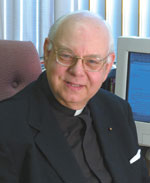Palm Sunday of the Lord’s Passion
/
Msgr. Owen F. Campion
The Sunday Readings
 This weekend, in a liturgy majestic in its ability to transport us to the events of the day that began the
first Holy Week, the Church celebrates
Palm Sunday.
This weekend, in a liturgy majestic in its ability to transport us to the events of the day that began the
first Holy Week, the Church celebrates
Palm Sunday.
The liturgy may be somewhat different. Some parishes have a procession to precede each Mass, ideally involving the entire congregation, who will carry palms blessed by the celebrants. These palms will recall similar branches used to acclaim the arrival of Jesus in Jerusalem centuries ago.
As if to describe what happened on the first Palm Sunday, the procession begins with a reading from St. Mark’s Gospel. This reading recalls the coming of Jesus across the Mount of Olives and from Bethany to Jerusalem. He approached Jerusalem from the East, just as the Scriptures had predicted as the route of the Messiah.
He came in humility. Roman leaders would have ridden into the city on horseback or in chariots. Jesus rode a donkey. As the Lord would insist days later to Pilate, the Roman governor, the kingdom of God is not of this world.
After this procession, the Liturgy of the Word progresses normally.
The first reading is from Isaiah. It is the third “Suffering Servant” song, emphasizing the fictional Servant’s absolute devotion to God despite all the hardships that would come.
The Book of Isaiah has four of these hymns of the Suffering Servant. They are most expressive and moving. Christians always have seen Jesus in this literary figure.
Supplying the second reading is the Epistle to the Philippians.
Eloquent and most compelling, scholars believe that its origin was liturgical. Early Christians used this hymn in their worship.
The hymn is an exclamation of the glory of Christ.
For the Gospel reading in the Liturgy of the Word, the Church this year provides the Passion according to St. Mark.
Each of the Gospels has its own perception of the Passion of Christ. For Mark, the special point is that the Lord was utterly alone as he faced trial and death. Judas’ betrayal, the young man who ran away, Peter’s denial, the failure of the religious scholars to recognize the Lord’s true identity and the kangaroo court itself all were important details for Mark.
Finally, Jesus stood willingly helpless before Pilate, the representative of the Great Evil, the pagan Roman Empire, earthly power at its zenith.
The Suffering Servant song sets the stage. Jesus, innocent and good, faces human sin and death.
This Gospel is a wonderful prelude to the story of the Resurrection to be told on Easter.
Reflection
People almost always can say where they were when they first heard about the horrible collisions of the hijacked planes with the World Trade Center towers and the Pentagon on Sept. 11, 2001.
Americans who were alive on Nov. 22, 1963, remember where they were when they heard that President John F. Kennedy had been assassinated.
Those alive on Dec. 7, 1941, remember hearing the first reports about the attack on Pearl Harbor.
People still talk about historical accounts of the Titanic, a British luxury liner, which sank with great loss of life on April 15, 1912, during its maiden voyage across the Atlantic Ocean.
Thus it was with the Evangelists. They vividly reported the Passion of Jesus. Their careful but individual reconstructions of the day indicates how vital the Lord’s trial and death were in the Evangelists’ lesson plan.
With Lent, the Church has prepared us for Holy Week. Mark tells us that Jesus faced the sin of the world, deserted by frightened, ignorant human beings. He faced death.
Each Christian, somehow, is in similar conflict. The Church bluntly reminds us of this fact, not in despair, but in hope. Follow Jesus to Calvary. Rise with Jesus to new life.
This is the Church’s message to us on this weekend. Palm Sunday begins the Church’s most profound lesson about the reality of life. †
 This weekend, in a liturgy majestic in its ability to transport us to the events of the day that began the
first Holy Week, the Church celebrates
Palm Sunday.
This weekend, in a liturgy majestic in its ability to transport us to the events of the day that began the
first Holy Week, the Church celebrates
Palm Sunday.